The main thing from the conference for those who create new media - MediaMakers-2016
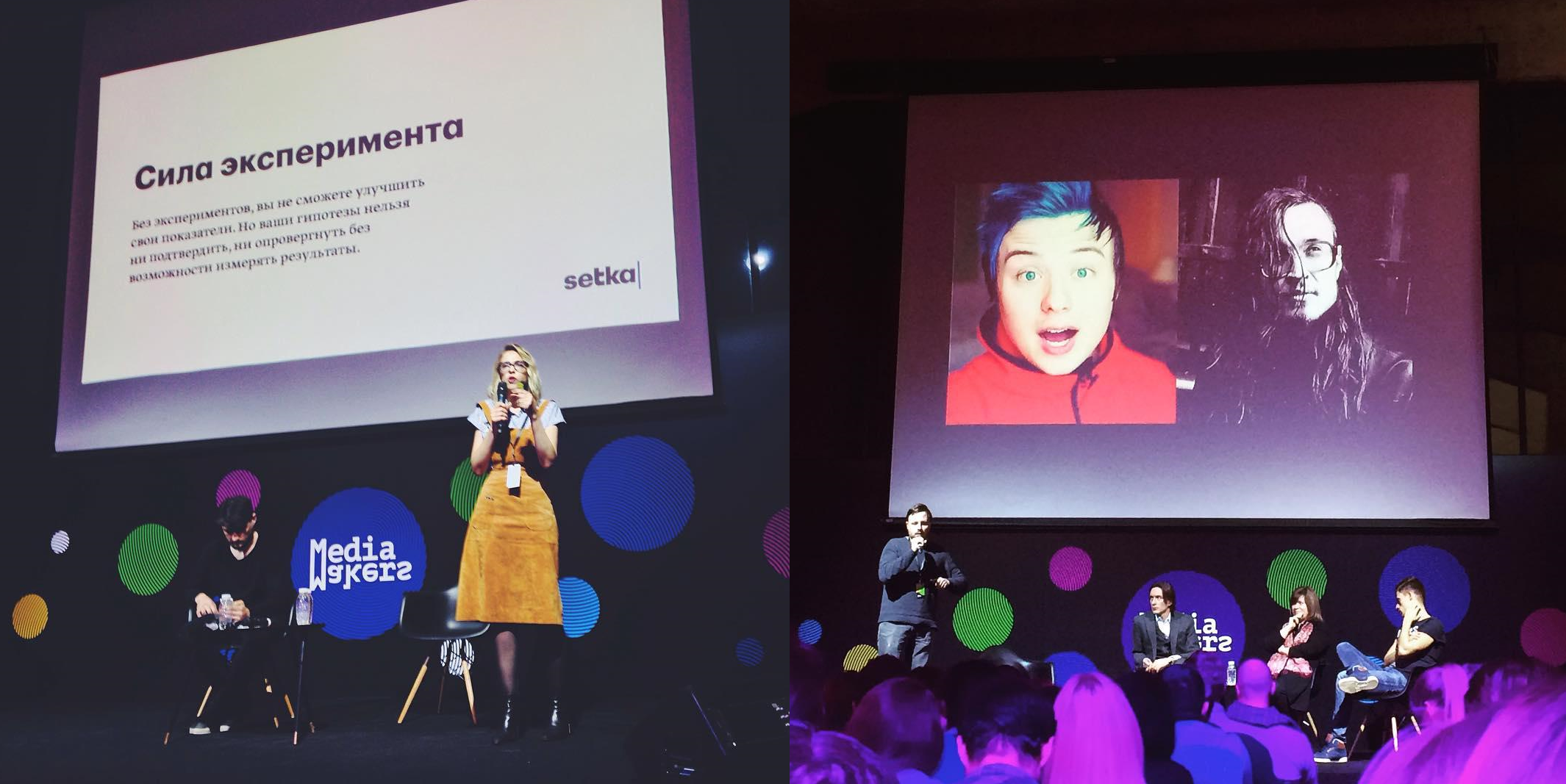
We collected theses of the most interesting reports from the conference for those who create new media. The publishers were Bild, De Correspondent, Meduza, Republic, AiTarget, Quartz, Sports.ru and RBC. We talk briefly about trends in journalism, native advertising and content monetization.
The main thing for Relap.io was chosen by journalist Alexandra Zhukovskaya .
')
The links - the main points of each statement:
- Kai Diekmann, publisher Bild: How we transformed Europe’s largest newspaper into a digital giant
- Ernst-Jan Pfaut, publisher of De Correspondent: How to create a successful media, relying only on the money of subscribers (and without advertising)
- Andrei Chernyshov, Managing Partner People & Screens: How to monetize mobile content: the state of the mobile advertising market
- Discussion “Native advertising - salvation for the industry. Or not?"
- Ilya Lagutin, CEO AiTarget: How to build an international media business on the platform of Facebook, Instagram and Messenger
- Gideon Lichfield, Quartz Senior Editor: How to compete with large editions, even if you have a small team
- Discussion “How should journalism work in 2016?”
How we transformed Europe’s largest newspaper into a digital giant
Kai Dickmann, publisher Bild
3 stages of Bild transformation:
1. Adoption
2. Analysis
3. To battle
The main theses of the speech:
In 1983, 30.1 million copies of newspapers were distributed in Germany. In 2016, their number decreased to 16 million.
The average smartphone user in Germany uses 12 applications daily, of which the largest (80% of the total share) - 3 applications: Google, Whatsapp and Facebook.
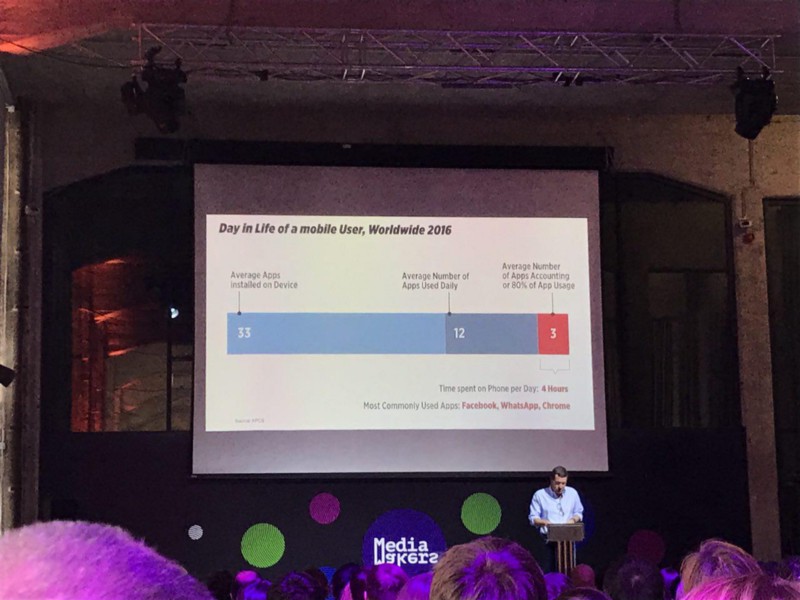
For German youth (14–18 years old), the main source of news is the Internet. More than 79% of young people constantly use the Internet from a smartphone.
Technology in Germany is seen as a threat: print media is afraid of losing an audience.
Creating the future, you can not use yesterday's methods.
The best stories and pictures are useless because they cannot find their way to the readers. Soul Bild - journalism, storytelling.
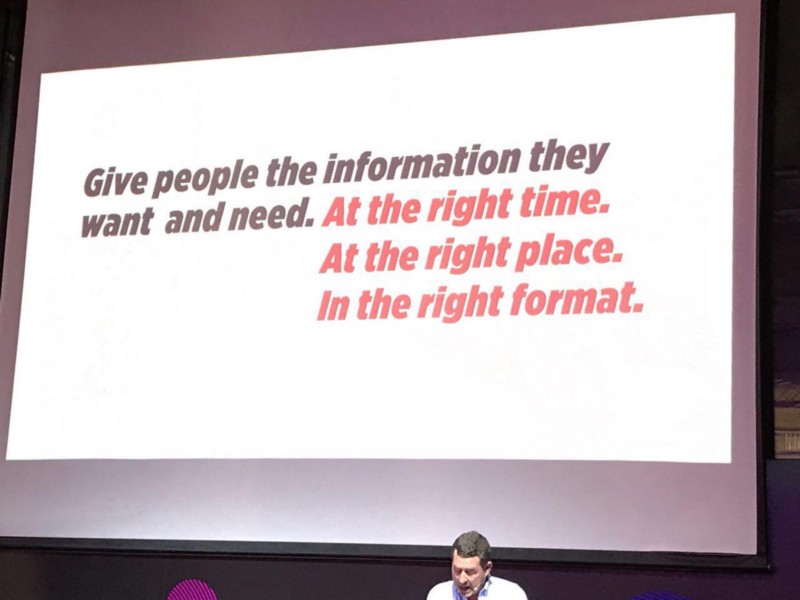
Young people in Germany often use 500 megabyte per month plans. Bild publish videos when young people are not at school, but at home, and are connected to WiFi.
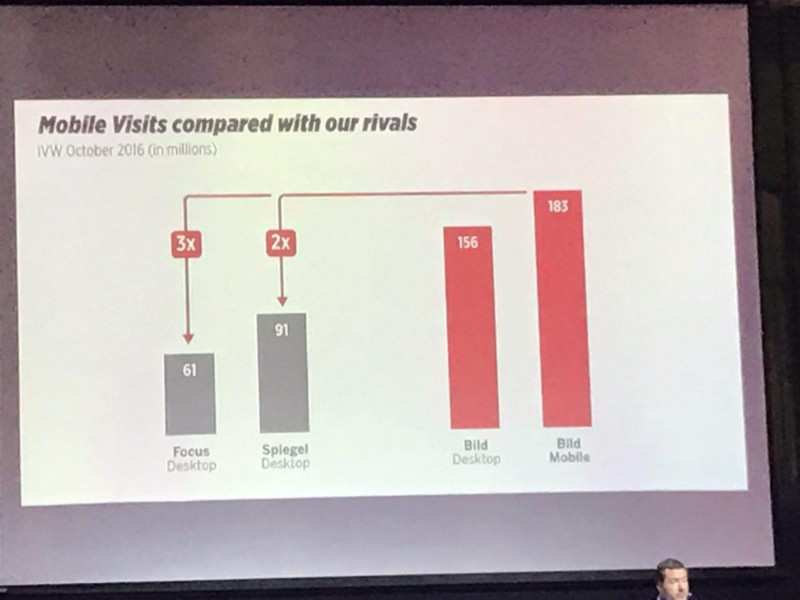
The share of visits from mobile phones from Bild is 2 times higher than that of Spiegel and 3 times higher than that of Focus.
Evening push notifications, according to Bild's experience, are 23% more efficient than morning ones (checked on notifications at 7 am and 10 pm).
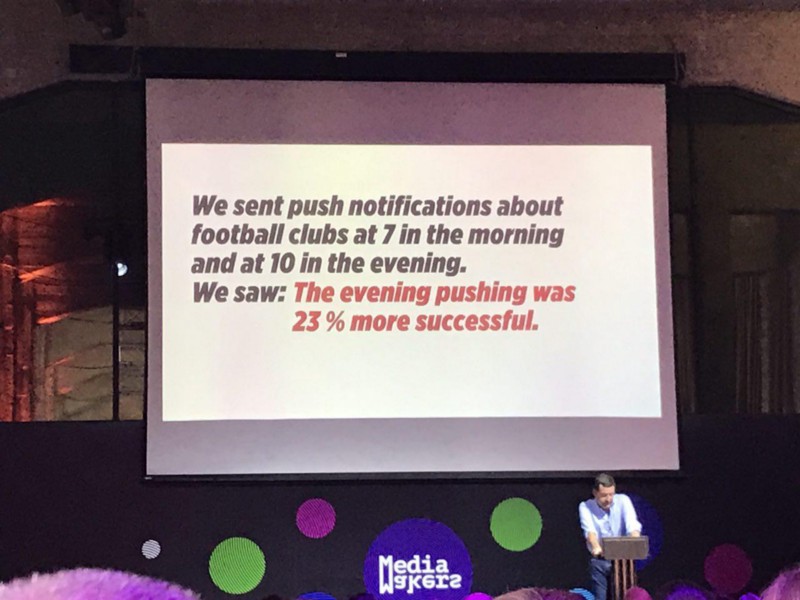
Bild go where their audience is. She migrated to the messengers - and Bild follow.
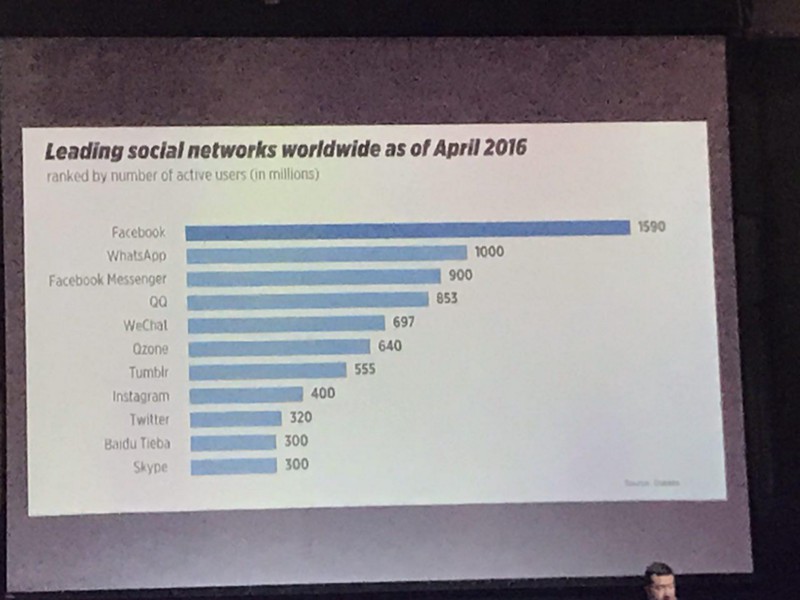
Video on Facebook is a very effective promotion tool: thanks to broadcasts from the scene, for example during terrorist attacks, you can quickly increase your audience (Bild has 6 million Facebook subscribers).
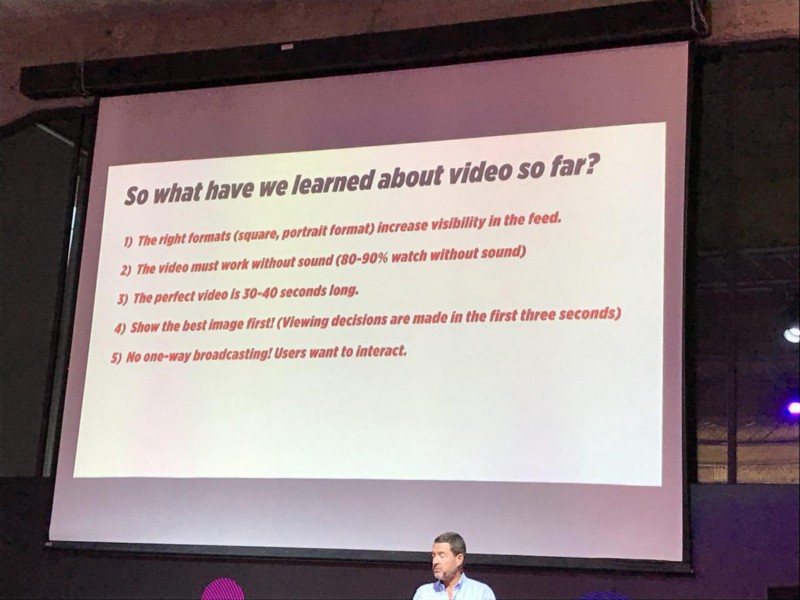
Secrets of the perfect video according to Bild
Bild hired the editors in Los Angeles to work during the day when it was night in Europe. As a result, the nightly angled - activity rating - has grown.
Trend 2017: 360 video on Facebook.
- Do not you feel the threat from the platforms because of their dictatorship? Facebook decides who is in the audience and when it sees your posts, and affects the reach.
- We all have no choice early, we have to be where 1.5 billion people are sitting. Facebook listens to us, and so far this is enough. Feel the danger, but nowhere to go.
- What do you think about Telegram? Do you distinguish it from other messengers?
- Telegram? (laughs) We don't know what it is. We are now working only on Facebook Messenger and are trying to succeed on Snapchat.
How to create a successful media, relying only on the money of subscribers (and without advertising)
Ernst-Jan Pfaut, publisher De Correspondent

De Correspondent collected 1 million euros for 8 days - this is the best media case in crowdfunding. The report focuses on how to rely only on subscribers' money and develop media.
The main theses of the speech:
War is a matter for the young. 3 years ago we were just young guys who were unexpectedly given high positions. In De Correspondent, 45 people work full time. Subscribers - 48000.
The job of the publisher today is to look for a place to publish in the reader’s daily media consumption, to determine the value for which the publication will be read every day.
For us, journalism is a business.
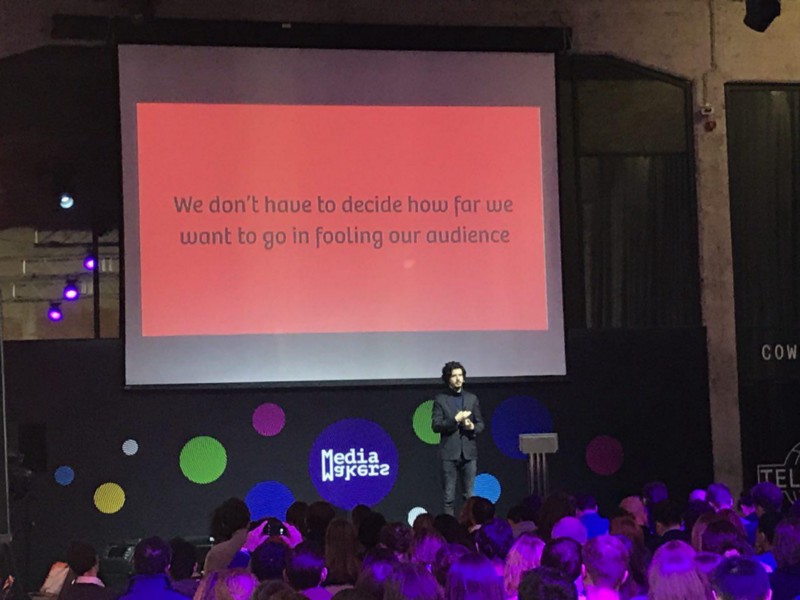
We will never sell ads.
According to analysts, 85 cents in every dollar spent on online advertising go to Google and Facebook. We decided that we would not compete with them, but would focus on how to better inform our readers.
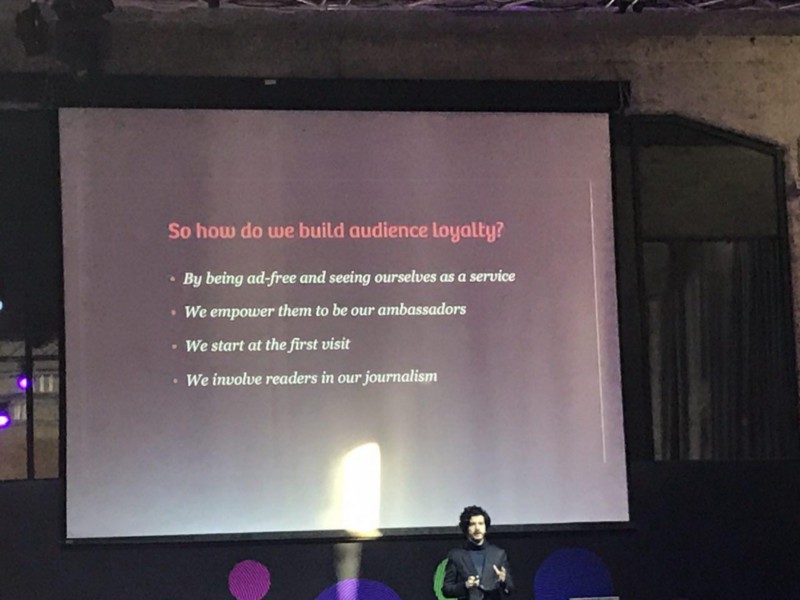
How to gather a loyal audience: consider yourself as a service and engage readers in the work on content
We involve readers in the creation of materials not only from business interest. We publish our shared stories, focus on the desire of the reader.
How to monetize mobile content: the state of the mobile advertising market
Andrei Chernyshov, Managing Partner People & Screens
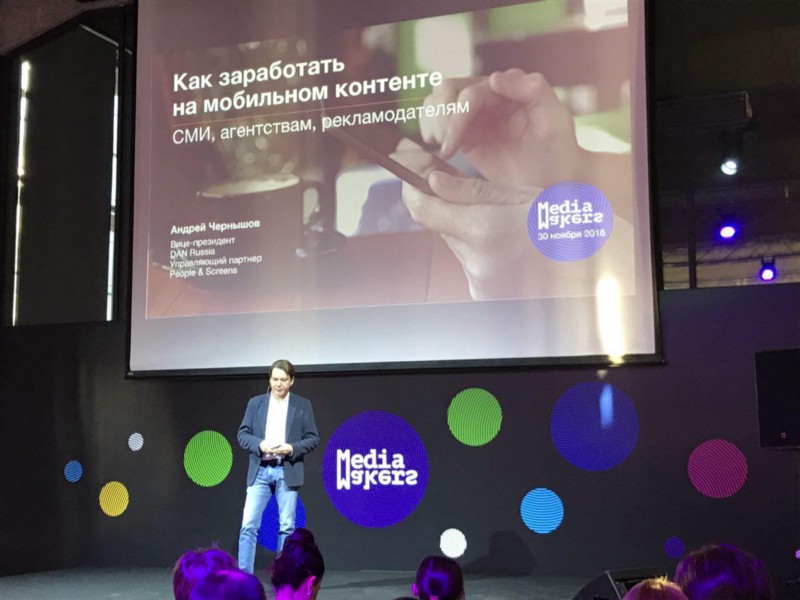
The main theses of the speech:
65% of daily traffic comes from mobile devices.
With the transition of the audience to the mobile, much needs to be started anew: half of the audience browses sites from mobile devices
The paper falls - minus 15% for the three quarters of 2016 compared to the three quarters of 2015. According to TNS, an audience of 16–34 spends only 5 minutes on the press per day. In the desktop, everything is not so bad: it grows more slowly according to timespend, it grows slower in budget. The overall increase is 16% for the market (including major players).
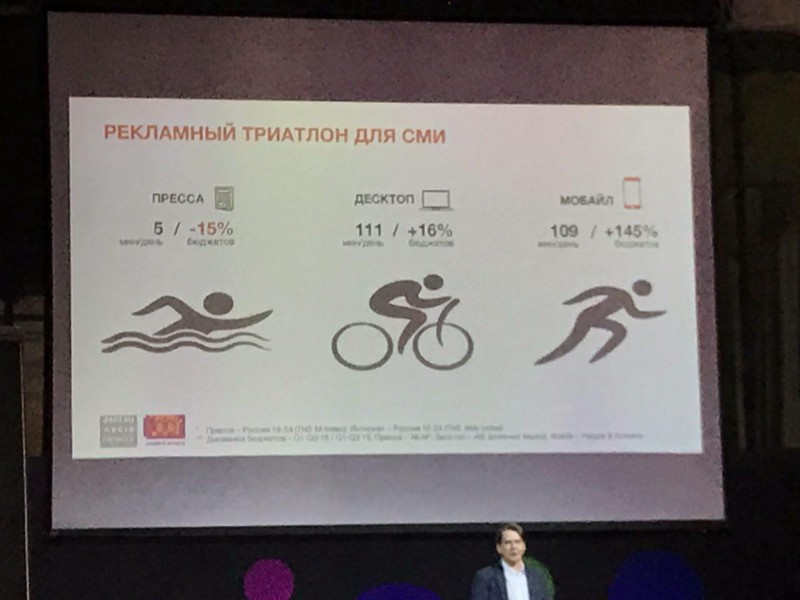
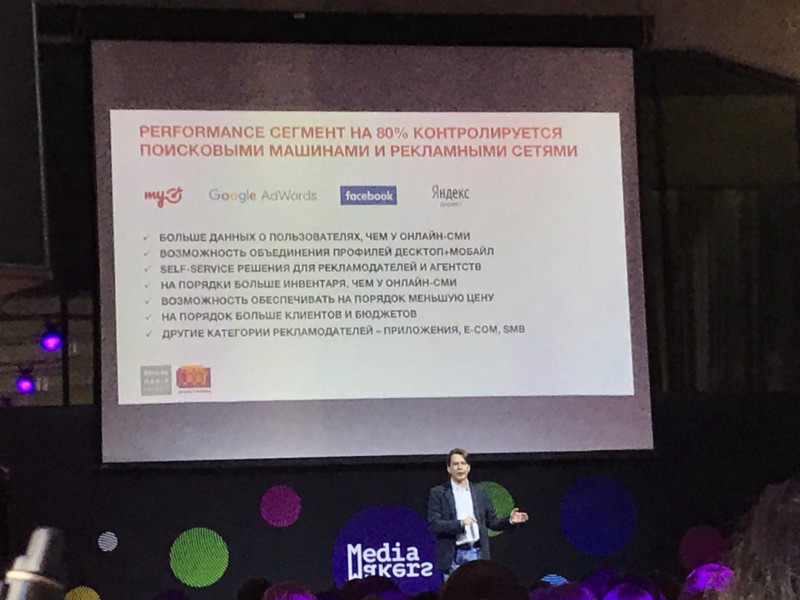
The maximum amount of money goes to the most recognizable site.
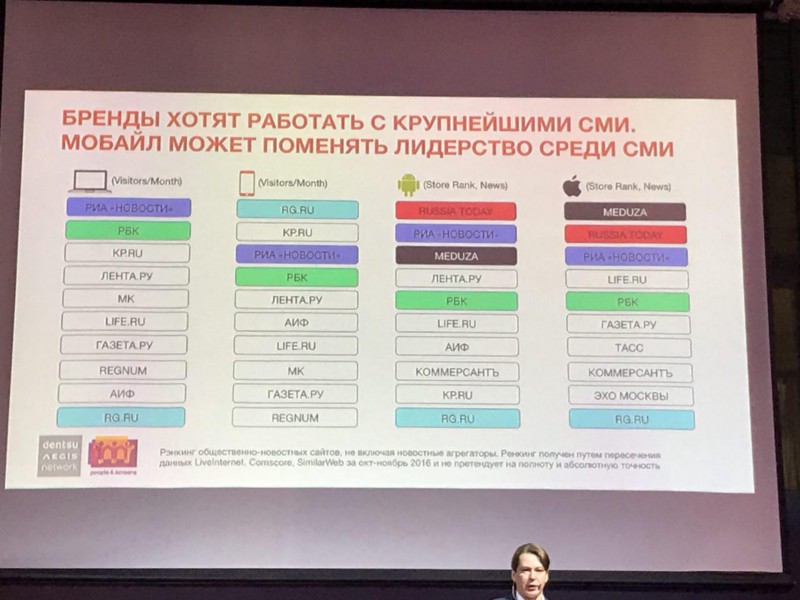
Thanks to mobile traffic and its cheapness, medium-sized media can qualify for a large piece of cake. But it’s more convenient for a brand to buy small media through networks.
What does the brand want:
- Work with the largest media
- Convenience of purchase (small media purchased through the network)
- Beauty (premium advertising formats)
- No bots
To increase the income of the publishing house, you can sell advertising package.
Native advertising - salvation for the industry. Or not?
Meduza publisher Ilya Krasilshchik, Yandex.Dzen media director Daniil Trabun, Republican publisher Maxim Kashulinsky
Sponsored Content Issues:
- “Bad” advertisers: it's great to make ads for good TV shows or McDonalds, but if it’s obvious that the product is not very good, the publishers refuse and reduce the number of their customers;
- Nativka casts a shadow on independent journalism;
- Efficiency is not completely clear: the user remembers the cool story, but does not remember who told the story to him;
- A nativka is very difficult to put on stream.
Highlights of the discussion:
Dyer: If you want to do native advertising, then there should not be a cool and non-class advertiser for you. "Classless" - the one who allows unethical acts, deceives the buyer. You need to decide for yourself immediately who you are placing and who is not.
“Bad” advertisers are a cool intellectual challenge when you need to come up with a good format for a product that seems impossible to submit.
Do a nativka so that you yourself do not consider it a jeans and not ashamed of what you did.
Nativka gives you: a) traffic b) a new format that strengthens the editorial.
The effectiveness of native advertising depends largely on how well you understand the client’s task.
Trabun: Previously only the media could tell stories. Now people are more likely to believe the brand, not the media: for example, they are more willing to believe the stories told on the Shell website, “a large company could not lie, and journalists lie all the time.”
Dyer: The monopoly on content creation has collapsed, anyone can create it. Brands are also trying, and some are doing pretty well.
Kashulinsky: In my opinion, it is strange by the results to have no effectiveness for the brand: for example, 90% of people passed the test, but they do not remember whose affiliate material it was. It seems to me that the matter is in the hype. Everyone wants native advertising because of HYIP.
Dyer: We must take into account the goals of the brand so that the reader will be pleased and we will not deceive him. There are customers who have no goals. Then we sit down and ask what you want. We do not work as consultants for the brand, but we are trying to understand what it wants. Efficiency can be measured in different ways: Buzzfeed - engagement, someone - prescrolls.
72% of the income Meduza gets from native advertising.
Dyer: Media has a bad reputation: a good review about a restaurant is perceived as jeans, bad - as jeans paid by competitors. In fact, “bad reputation” is a hoax. (Medusa often makes corrections to the text, having received feedback from readers, or removes material from the site if too much is done poorly in it - so as not to mislead readers).
“Sponsor Material” is material that the advertiser cannot interfere with. Subject material may not intersect directly with the customer advertising. “Affiliate Material” implies that both parties are involved in its creation.
How to build an international media business on the platform of Facebook, Instagram and Messenger
Ilya Lagutin, CEO AiTarget
Facebook is a huge platform in which, cumulatively (along with Instagram, Snapchat and messengers), the audience is larger than the number of residents in any country.
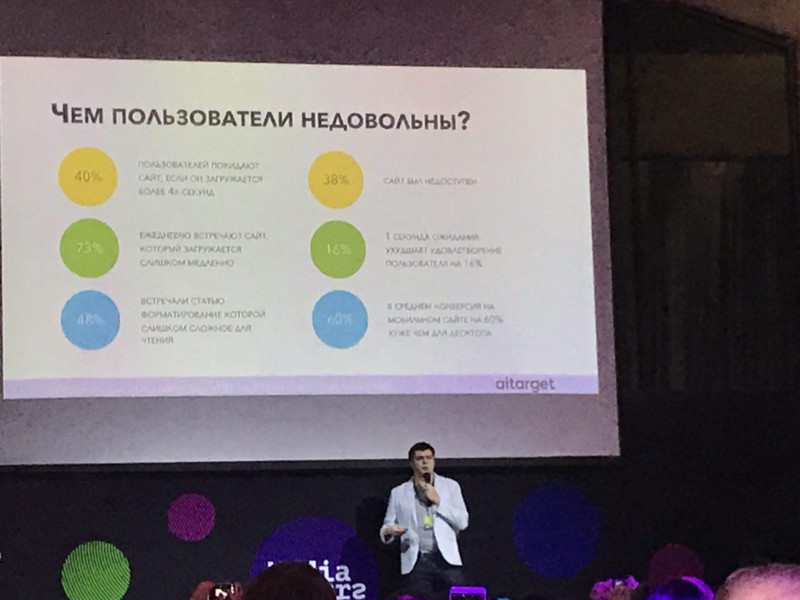
Main theses of the speech:
There are 3 ways to monetize Instant Articles:
- Embed code for direct sales inside the article;
- Audience Network - to sell advertising to Facebook, you can use it both on the site and in the application;
- Branded content.
Another way to attract and monetize on Facebook is video:
- Live (voting, live broadcasts from events);
- Panoramic video;
- With the help of the video, you can not only distribute content, but also sell advertising - inside the video.
6 of the 10 most popular applications in the world are instant messengers.
For effective use of instant messengers, you can use bots - interactive buddies who can deliver content. In the west, bots are more popular than ours.
How to effectively develop media through Facebook:
- Pay attention to relevance core, analyze and segment data about your audience;
- Use look-a-like;
- Use live and video;
- Work with Instant Articles, do not seek to lead to use the site;
- Experiment - test which pictures, titles and text work best to attract the audience;
- Automate work - do bots via Chatfuel;
- Audience network - use Facebook advertising opportunities;
- Personalize your work with the audience - with the help of bots, live and instant messengers.
How to compete with large editions, even if you have a small team
Gideon Litchfield, Quartz Senior Editor
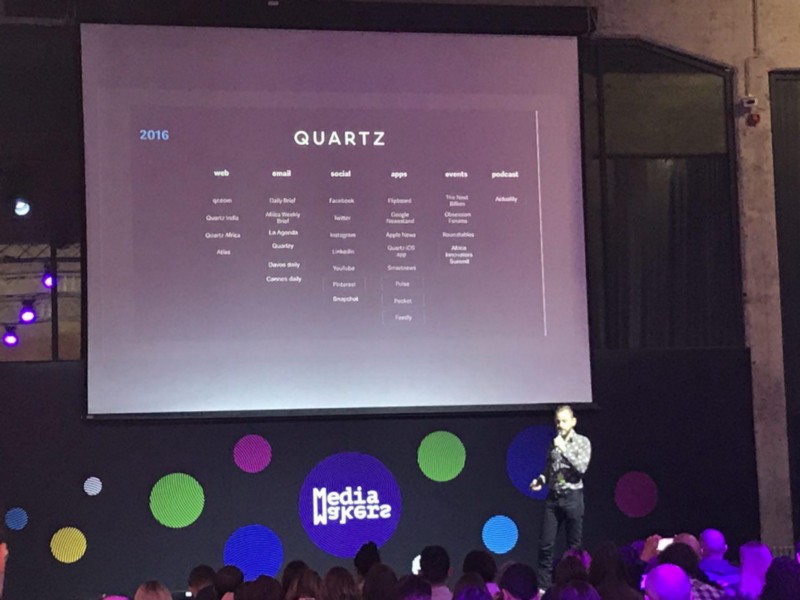
The main theses of the speech:
What we understood:
They come to us not through the home page, but through messengers, social networks and aggregators. Therefore, each story must sell itself.
Quartz Curve: if every plot has to sell itself, there should be one main point in it. Often publications, having published a material or a plot, update it, supplement it with details, and the material is filled with stories. And the reader does not remember these stories. We try to give one story in one plot, whether it is long material or short.
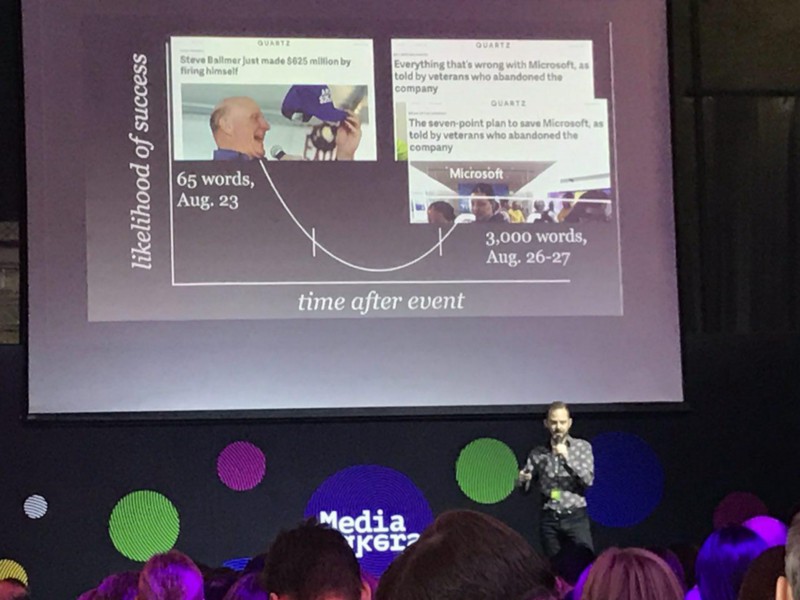
An example from Microsoft: they immediately give information, even if from 65 words, then supplement - the material grows to 3000 words
Like any website, we are looking for interesting ways to apply the possibilities of the Internet, experimenting with formats: for example, we wrote about inflation in verses, published only infographics instead of text.
We created a tool for every journalist to create an infographic without contacting the designer or developer - Atlas. It can be used by journalists all over the world. We want it to be accessible and easy for everyone.
We have 4 Quartz sites in different languages, an Atlas infographic site, applications. Quartz is not a site, but a cross-platform media.
How to do journalism in 2016?
Anna Kachkaeva (HSE), Yury Dud (Sports.ru), Yury Pogorely (Interfax), Alexander Urzhanov (RBC).
The main question: hybridity, fluidity and uncertainty in the industry.
Trends:
- Non-profile people come to news journalism. Now the journalist is a communication center around the community;
- Cross-platform;
- Native advertising is a challenge for journalism;
- Visuality - augmented reality, journalism of impressions.
How to be noticeable, heard and not hungry? This is a discussion.
Highlights of the discussion:
Dood: I expect that timekiller toys will be made not by programmers, but by the journalists themselves. If we do not know how to do this, they will not take us to the future.
What a journalist should do in order not to be left without money:
1. Learn to program.
2. Learn to sell.
3. To be interested in new things - to be taken to the future, leave snobbery or go to work for the All-Russian State Television and Radio Broadcasting Company.
4. Understand: everything can end right tonight - without realizing that journalism is a bit of volunteering, without feeling that the profession lives for today, you cannot go to the future. Less serious about yourself, not being afraid to experiment.
The most important thing is to resonate. There is too much content now, and it is impossible without experiments.
Lost: The media is now performing a service function - they must fit into the reader’s life process. If you do not fit, you will lose.
Urzhanov: I have been doing journalism for 12 years. At first I was taught to write at MSU. Then I studied in the editorial. Then I began to learn to understand the panel Gallup. Every year, everything that I can, is reset, it becomes more irrelevant. And I wonder why this is happening.
This year, the world artistic process has come to the conclusion that language is most important. Even in the story about the arrival of aliens the philologist becomes the main person. In journalism, we have been communicating with the same people for years and it seems to us that they already know and understand everything. But it is not.
Political memes are the language people speak. Political journalism is memes. One might think that political journalism is the Republic, for example, but as long as we think so, millions of people consume content in the form of memes.
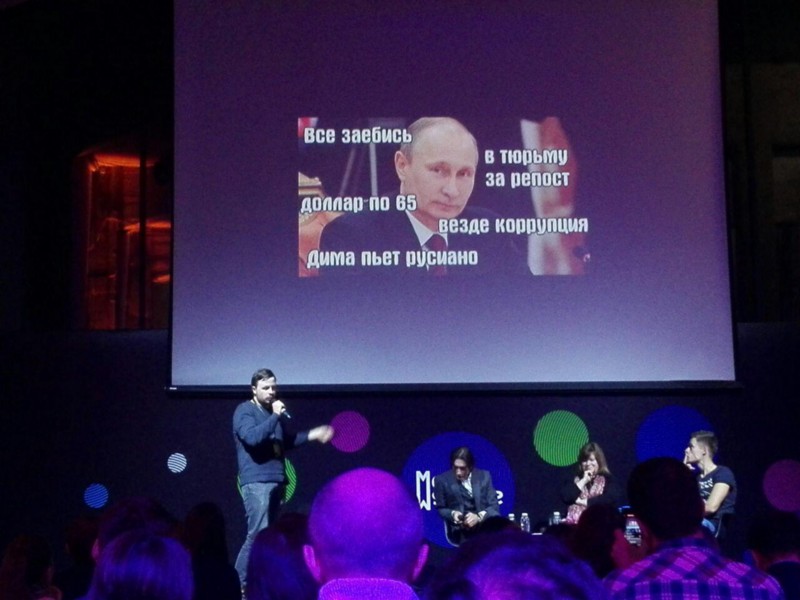
The media do not understand what the audience is: the one that consumes memes, the one that writes “shkolota, go fucking”. Media do not understand how to monetize Telegram, and lose communication with the audience. Telegram outside their radar.
The video bloggers for the audience will be like Egor Letov for the seventies, they are the heroes of this generation.
We want to be able to involve people in the same way as bloggers do - but we cannot, because we don’t speak their language.
RBC initially - stock media. We sold people the dream of how to make money on the stock exchange. This dream collapsed 8 years ago, but we still live by it and communicate in the exchange language.
Coming to a person to whom I do not need, but to whom I must say something and grab his attention, I must speak his language.
Cover photo (left) - Victoria Vovk
Source: https://habr.com/ru/post/316628/
All Articles